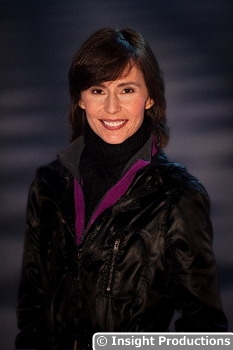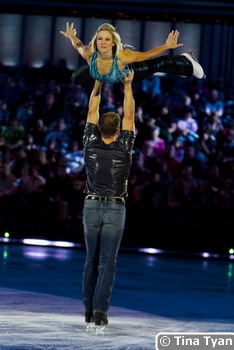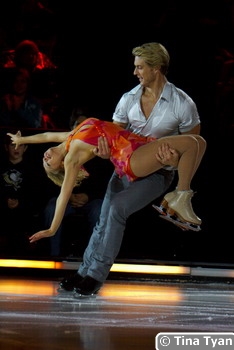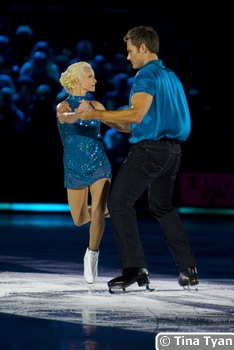Choreographing the Battle of the Blades
November 9, 2011
By Tina Tyan
Photos © Tina Tyan, Insight Productions
This weekend on CBC, Tessa Bonhomme & David Pelletier, Marie-France Dubreuil & Bryan Berard, and Tanith Belbin & Boyd Devereaux face off on the ice to determine who will be the winners of this yearâs Battle of the Blades. Every week, these pairs have raised the bar higher and higher, dazzling fans with their daring tricks and entertaining performances.
What audiences may not realize is that each pair is not alone on the ice. Behind every pair is a third, often invisible member of the team: the hard-working choreographer. Part coach, part mentor, and part strategist, the choreographer of each team plays a key role in balancing the experience of the skater against the tenacious strength of the hockey player to produce stunning performances time after time.


I recently had the chance to interview the choreographers behind two of the finalists: Renee Roca, the choreographer for Bonhomme & Pelletier, and Michael Seibert, of team Dubreuil & Berard. Neither Roca nor Seibert are new to the Battle. Roca previously helped Jamie Sale & Craig Simpson triumph in season 1, while Seibert coached Ekaterina Gordeeva & Val Bure to victory in season 2.
Three-time US National Dance Champion Renee Roca and five-time US National Dance Champion Michael Seibert are no strangers to creative choreography in a diverse array of situations. Between the two of them, they have worked on five seasons of Battle of the Blades for CBC, performed, choreographed, and directed over a dozen seasons of Stars on Ice, codirected and choreographed numerous television specials and tours, and even tried their hand at choreographing FOXâs Skating with Celebrities.
 All this experience serves them well when tackling the challenges that Battle of the Blades throws at them, the biggest of which is the extreme time constraints of the show. After an initial bootcamp in the summer, the skaters are paired and assigned a choreographer. From that point, the teams have only three weeks to learn essentially everything they will need to know how to do in the show.
All this experience serves them well when tackling the challenges that Battle of the Blades throws at them, the biggest of which is the extreme time constraints of the show. After an initial bootcamp in the summer, the skaters are paired and assigned a choreographer. From that point, the teams have only three weeks to learn essentially everything they will need to know how to do in the show.
âWhen we have our three weeks in September, I stress very hard [to the players], weâve got three weeks to learn our language, and we have to learn everything in those three weeks,â Michael Seibert explained. âA lot of that means we do a bunch of lifts off the ice in those three weeks because once this train leaves the station, you donât have real time to learn new skills, even though theyâre actually getting better as skaters.â
Once the season starts, it becomes a cycle of ââItâs Monday morning and weâve got to start the new choreography, and you might still have to skate off on Monday night, but by Tuesday, Wednesday and Thursday, the number has to be done, because weâre into dress rehearsal on Saturday.â So the scheduleâs brutal and you donât have a lot of new learning time in that schedule. You have to have done it. Or you have to have at least laid the groundwork in September for that.â
With so much to do in so little time, it is very important for the choreographers to get to know their pairs and their personalities really well, and to quickly establish a rapport and communication. While the hockey players have the advantage of already knowing how to skate, and the body awareness that comes from being an athlete, figure skating is a whole other world. As Renee Roca explained, âin figure skating, we have a whole language for turns and steps and directions and edges. Thereâs just this whole vocabulary that these hockey men, even though theyâre skaters, have no idea about. They just know, go fast, go backward, go forward.â Years of ingrained habit add another layer of frustration to the process, as these skilled athletes have to supplant instinct with conscious thought and technique.
 âYou know, just to turn backward, they might just kind of hop forward to backward, they donât really think about the technique of the feet. And when we show them turns and things, itâs hard for them. They canât get it, theyâre like âWhy canât I get this? I can skate!ââ Roca elaborated. âAnd itâs really hard for them. They get really frustrated, actually.â
âYou know, just to turn backward, they might just kind of hop forward to backward, they donât really think about the technique of the feet. And when we show them turns and things, itâs hard for them. They canât get it, theyâre like âWhy canât I get this? I can skate!ââ Roca elaborated. âAnd itâs really hard for them. They get really frustrated, actually.â
Similarly, although the hockey players are extremely strong, lifts require technique, timing and different muscle groups than the hockey players are used to using. Lifts also present an entirely different challenge that has nothing to do with physical power.
âEach week, thereâs so many new things for these guys. [From] counting music, to balancing a girl over your head, to getting used to, you know, inappropriately grabbing a girl whoâs not your wife in the wrong...â Seibert laughed. âChallenge-wise for these guys, itâs all a completely different world. Itâs what we take for granted as male figure skaters - you know, grabbing a girl on the way down, it doesnât matter where she is as long as she doesnât hurt herself.â
âAnd you know, these guys are trained very differently,â Seibert added. âAnd itâs charming. You know itâs a very - I want to say âold-schoolâ - kind of manners that they just wouldnât be doing [that] to somebody other than their wives! And I donât mean that to sound as dirty as it did...â
Of course, the choreographers do get help. For one of her teams, Elena Berezhnaya & Curtis Leschyshyn, Renee Roca relied on Paul Martini as her âright arm guy.â He would help Curtis with lift technique, while she worked with Elena on the patterns and movement to develop the program. In the case of Tessa and David, however, David is âjust so strong as a partner and a technician that he and I just kind of do it together, and then we teach it to Tessa.â
As the weeks go on, the entire team has to battle fatigue on top of all their other challenges. There are no days off. The skaters get injured, they ache all over, but thereâs no time to rest and recover, which makes it that much more challenging to learn and retain new things. The choreographers have to take all this into account when planning their programs each week, with what little time they have to plan.
Renee Roca said that even though they donât usually start with the next weekâs program until after the show on Sunday, her mind is constantly working and planning ahead, and that sheâll sometimes work out ideas in her hotel room so sheâs ready with ideas when they hit the ice. âI donât want to waste time, thatâs the thing. Our ice training time is precious. So I try to have things thought out. I go to my hotel room, and I kind of run around my floor, and I think about things, so that I can come in and say, ok weâre going to try this this and this, and weâll see what works, and what doesnât work gets knocked out, and what works has potential to stay.â
 Michael Seibert takes careful note of what seems to work, and what doesnât. âVioletta [Afanasieva] and Cale [Hulse], for instance, week 2 we did a very soft, almost a rhumba, and I donât think it was very successful. I think it was our least successful program. And so when Iâm picking music for them now, I think that theyâre better when theyâre picking something with a better beat, and something thatâs a little more fun. Bryan and Marie-France seem to have quite a romantic chemistry between them, that is something that I can use. So, I try to find things where itâs more of a male-female role-playing kind of thing, that helps to set the choreography and lets you have a hook to work from.â
Michael Seibert takes careful note of what seems to work, and what doesnât. âVioletta [Afanasieva] and Cale [Hulse], for instance, week 2 we did a very soft, almost a rhumba, and I donât think it was very successful. I think it was our least successful program. And so when Iâm picking music for them now, I think that theyâre better when theyâre picking something with a better beat, and something thatâs a little more fun. Bryan and Marie-France seem to have quite a romantic chemistry between them, that is something that I can use. So, I try to find things where itâs more of a male-female role-playing kind of thing, that helps to set the choreography and lets you have a hook to work from.â
Understanding the skatersâ strengths and weaknesses includes knowing when they prefer the choreographer to take charge and pick the music, and when to work with them to determine music choice. For instance, Seibert says that âBryan Berard is a very musical guy. He listens to what I find quite interesting music, so he has a point of view thatâs really fun.â It was Bryan who suggested the music for Seibertâs favorite program of the season, Avril Lavigneâs Sk8er Boi.
It also extends to deciding how to best showcase their skills over the course of a season. âYou do have a bit of a strategy because you know, the really hard tricks that you might start in September, are not the tricks Iâm going to put in week 1. You need to keep some of those in reserve, because like I just said, you canât actually learn them in week 8,â Seibert explained. âSo you sort of have to have kept them in your back pocket, and then depending on the talent, you have to know which week actually you need to be putting in the extra stuff just to keep them a part of the game. Because if youâve held all the good tricks to the end then you got voted off the island because you werenât doing anything good enough in the front, then whatâs the use of that?â
 Overall, despite the challenges, both Seibert and Roca find the experience of working with the hockey players on Battle of the Blades extremely rewarding, and praise the players highly. Roca enjoys watching the light bulb come on as the hockey players learn, and listening to their conversations as they commiserate about the things they are learning and struggling to do. She laughs fondly when describing watching them walk down the halls when they think theyâre unobserved, working on the arm gestures and movements. âItâs been a really good group. These guys are really fun. They really really are. Thereâs a really good camaraderie with this group.â
Overall, despite the challenges, both Seibert and Roca find the experience of working with the hockey players on Battle of the Blades extremely rewarding, and praise the players highly. Roca enjoys watching the light bulb come on as the hockey players learn, and listening to their conversations as they commiserate about the things they are learning and struggling to do. She laughs fondly when describing watching them walk down the halls when they think theyâre unobserved, working on the arm gestures and movements. âItâs been a really good group. These guys are really fun. They really really are. Thereâs a really good camaraderie with this group.â
Seibert concurs. âI mean these hockey guys I think are just fantastic. And theyâre really fun, because they are really skilled athletes and they come here as skilled athletes and competitors, and they are just switching mediums, and itâs really exciting to watch these guys want to challenge themselves, understand what the challenge is, and go about conquering it.â



